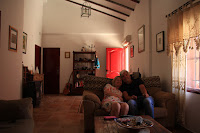Do British people still use the term Chelsea Tractor?

Just after lunch a convoy of three tractors passed our front gate. They had the folding umbrella type contraptions on the back that are used to collect almonds. The tractor reverses up to the tree, grabs the tree trunk using some hydraulic thingummy and then fans out the expanse of plastic tarpaulin type material to surround the tree. With the tree grabbed and the material in place the tree is given a good shaking and the almonds fall into the fan of material and roll tractorwards to a collecting chamber. When the collector is full the nuts are usually transferred to a trailer or a lorry and taken off for processing. It just so happens that there is quite a large nut processing factory (I originally wrote processing plant but I thought that may lead to confusion) in Pinoso. On the smaller plots, you'll often see a family group going at an almond or olive tree with sticks with a big sheet or net spread out under the tree to catch the falling fruit. The tractor driver I talked to to...

















